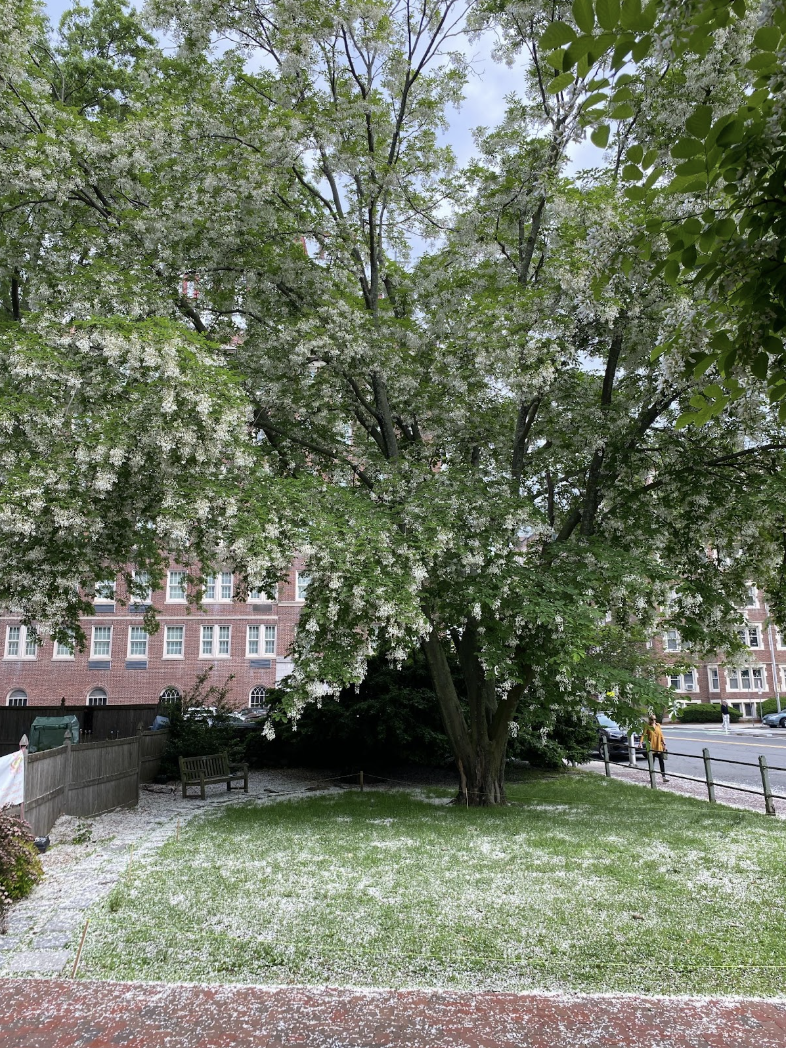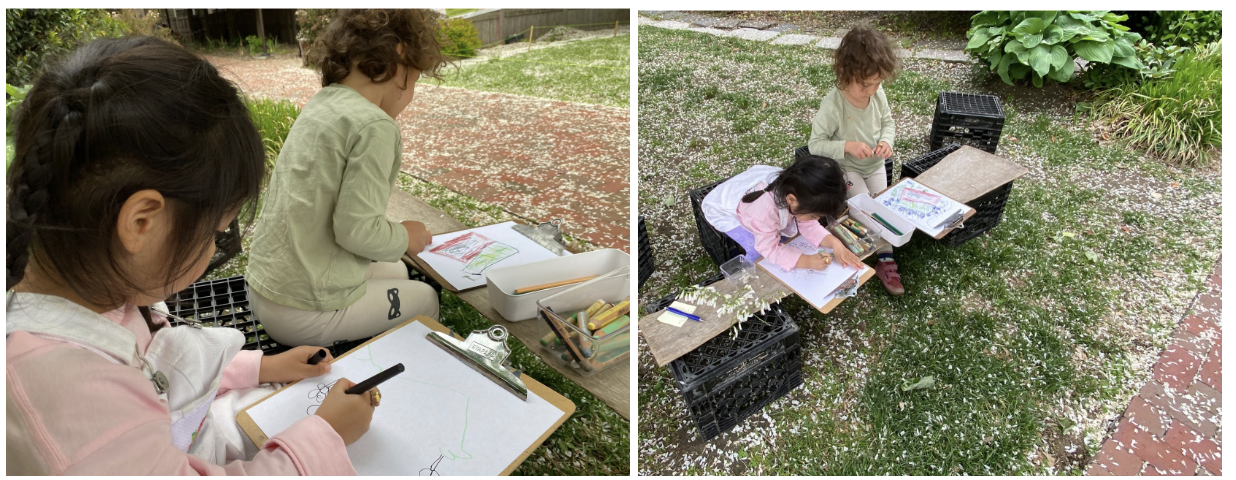Goodbye Yara, we love you

A bittersweet afternoon
In many ways, last Thursday afternoon was idyllic. It was a delightful spring day. The Kentucky Yellowwood trees in front of our school were in bloom, raining down white pedals like snowflakes. One particular Yellowwood, over 30 feet in height and covered with white flowers, could only be described as magnificent.
Since Kentucky Yellowwoods only flower every three or four years, this was not an opportunity to be missed. I invited Yara and Jolly, four-year-olds from the Blue Otter class, out to draw the trees. We proceeded to sit together for forty-five minutes.

At times, the girls sat in silence, drawing the tree, the red brick sidewalk, and other features in their view. At times they talked about what they were seeing. Yara exclaimed, “Look – leaves!”, noticing the green behind the white flowers, prompting her, and then Jolly, to include them in their drawings. They happily showed me the twin rings with bear figurines that they were wearing, and we observed that my wedding band did not have a bear attached to it. An ambulance passing by prompted Yara to note, “Someone is in trouble.” The girls then speculated on where the emergency vehicle was going. Occasionally a family member, on their way to pick up their child, would pause and ask what the girls were up to, providing me an opportunity to share a bit of information about the tree they were drawing. A couple of times Yara got up and danced around, seemingly out of pure happiness. Throughout, the mood was upbeat and relaxed.
But this was also a bittersweet afternoon. It was Yara's last day at our school. She and her family, Ukrainian nationals, were, in the parlance of the Trump-Vance administration, self-deporting. Feeling unsafe in their adopted country, they were moving to Vienna, Austria to start a new life. For myself, Jolly, and the rest of the school, this was our goodbye to Yara.
A loss to our community
Yara was new to our school in September. Entering without any English, she quickly picked up the new language. Her teacher, Danielle Hart, recounts that:
Yara was friends with everyone in the class. If someone was sad or hurt, Yara was there to help. She was full of ideas and stories to share and is an accomplished artist…Each day Yara would enter school and dance around in joy, happy to be with her friends and teachers.
Yara’s parents, Katia and Anton, were also important members of our school community, forming friendships with other families and children in Yara’s class.
The day after her departure her classmates were asking after Yara. Carter wondered when she would return. Elliot hoped she would visit soon. Juan made cards to send to her. Jolly cried, remembering her friend. Yara leaving is a loss to the Newtowne community.
Yara and her family leaving is also a loss to the U.S. I have now been teaching long enough to have seen the trajectory of humans from early childhood into adulthood. Yara has the profile of a young child who will grow up to be an accomplished adult. While I can’t predict the field – it might be medicine or the arts or she might become an entrepreneur – I am confident Yara will do great things. Austria is better off because she will be there and we in America are worse off as a result of her departure.
A tree with a story
The tree Yara and Jolly were drawing is a tree with a story. As its name implies, the tree is not native to Cambridge. It was planted over 150 years ago by Harvard botanist Asa Gray. Born in upstate New York in 1810, Gray was one of the leading American scientists of the 19th Century. He published widely and was part of an international network of scientists who exchanged ideas and information. Gray was a strong supporter of Darwin’s theory of evolution, helping publish The Origin of Species in the U.S. He believed that all of humankind is genetically related and abhorred slavery.
Despite being born almost two centuries apart, Yara and Gray have a lot in common. They both came to Cambridge from other places. They have friends from around the world. They are curious people. They have a love of the natural world and a special affinity to a specific Kentucky Yellowwood. And they both planted seeds, actual and metaphorical, from which plants and ideas grew.
A small example. The morning after Yara’s departure her classmates were out on the playground. Their teachers had set up a drawing area with a perfect view of Gray’s tree. Many spent a long time drawing the tree and other plants, as a friend commented, “Just like Yara.”
Making cruelty visible
Yara’s departure is very sad. I also find it incredibly frustrating not to have an immediate recourse to remedy such an obvious injustice. I wonder what I can do.
Of course, there are many things I should do: among them – protesting, contributing to democratic causes, and voting. And one action I am committing to (in this essay and in the future) is making cruelty visible.
Four months into the current administration there are now countless stories of cruelty and callousness that impact those of us in the U.S. and around the world. It is easy to become overwhelmed and fatigued by the sheer number of stories.
I see this essay as planting a seed. When you learn of stories such as Yara, stories that illustrate the cruelty of current policies, share these stories with family and friends. My hope is rather than the quantity of stories overwhelming us, that the number of stories will overwhelm them. That is, in time, the consequences of policies to individuals, families, communities, and ecosystems will add up; that those not yet outraged will understand that the U.S. is being weakened. That when people think of the current administration that they will think of Yara and others. In order to make this happen, we need to keep sharing stories. We need to make the cruelty visible so that we can dismantle it.
Thanks to Lee Prouty,, the Facilities Manager of the First Church of Cambridge (our landlords) for educating me about Asa Gray’s Kentucky Yellowwoods, and Amos Blanton, Caitlin Malloy, and Danielle Hart for feedback on this essay.
